By Patti Donohue from Johnson Street Global Studies
OVERVIEW OF LESSON: In this lesson, students will be introduced to two photographers, Camille Seaman and Chris Jordan, whose work incorporates themes of climate change and mass consumerism (Sustainable Development Goals 12 and 13).
Students will hear Camille Seaman reflect on the emotional and cultural connection between her Native American heritage, nature, and her photographs of icebergs in her series, A Matter of Time.
They will read Chris Jordan’s statement of hope from his photographic series titled, Intolerable Beauty. Jordan states: “As an American consumer myself, I am in no position to finger wag; but I do know that when we reflect on a difficult question in the absence of an answer, our attention can turn inward, and in that space may exist the possibility of some evolution of thought or action. So, my hope is that these photographs can serve as portals to a kind of cultural self-inquiry.” This lesson makes a connection between the balance needed to live sustainably and using balance in art.
Students will learn that artists’ statements explain their intentions for their work.
Students will create mixed media (watercolor and colored pencil) drawings showing their understanding of the principle of design and balance as well as write an artist’s statement.
SUGGESTED GRADE LEVELS: Grades 6-8
SUBJECT: Visual Art
CORRESPONDING NATIONAL AND/OR STATE OF NORTH CAROLINA STANDARDS:
NC Visual Arts Standards
6.V.1/ 6.V.1.4: Recognize how artists use the Elements of Art and Principles of Design in creating art.
6.V.2/ 6.V.2.3: Understand that original imagery is a means of self-expression used to communicate ideas and feelings.
7.V.2/ 7.V.2.3: Create original art emphasizing selected elements and principles to express ideas or feelings.
8.V.1/ 8.V.1.2: Apply the elements of art and principles of design in the planning and creation of personal art.
8.V.2/ 8.V.2.3: Create original art that conveys one or more ideas or feelings.
ESSENTIAL QUESTIONS:
- Which of the three types of balance are evident in Camille Seaman’s iceberg photographs?
- How do Chris Jordan’s photographs express his concern about the environment?
- Does your artist’s statement describe your use of the principle of design, balance, to express your idea/ feeling?
LESSON OBJECTIVES:
- Students will be able to identify balance in artwork.
- Students will be able to interpret meaning in artwork.
- Students will be able to create artwork that expresses their ideas through balance.
BACKGROUND INFORMATION FOR THE EDUCATOR or RESOURCES TO EXPLORE FURTHER:
- https://www.camilleseaman.com/photographs
- https://www.camilleseaman.com/about
- Photographer Camille Seaman captures an icy landscape that’s melting away
- https://video.kqed.org/video/brief-but-spectacular-1659640386/
- http://chrisjordan.com/gallery/intolerable/#about
- https://sdgs.un.org/goals/goal12
- https://sdgs.un.org/goals/goal13
- https://www.getty.edu/education/teachers/building_lessons/principles_design.pdf
- https://writingcommons.org/section/design/principles-of-design/balance/
- Watercolor Painting Seascape How to Paint Sky and Water Reflection
- https://www.education.vic.gov.au/school/teachers/teachingresources/discipline/english/literacy/Pages/writing-the-artist-statement.aspx
- World’s Largest Lesson Animation: Part 1 | The World’s Largest Lesson (globalgoals.org)
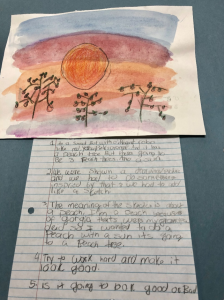 |
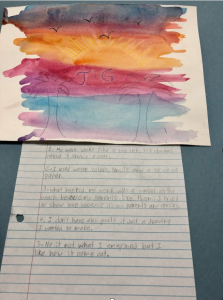 |
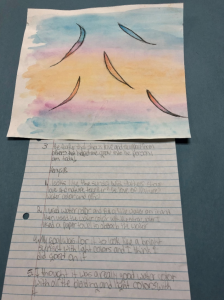 |
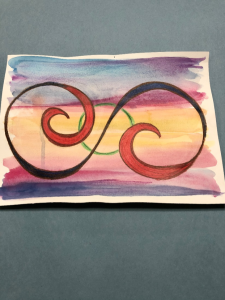 |
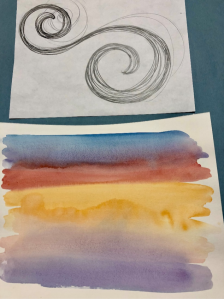 |
Above: Three student examples of finished product with artist’s statement, teacher’s example of watercolor with practice sketch of part 2, teacher’s example of finished product. Student and teacher artwork used with permission.
SPECIFIC STUDENT STRATEGIES & ACTIVITIES:
Day One
Opening attention getter- have a photograph from Camille Seaman’s A Matter of Time series on the screen for students to see when they come in. https://www.camilleseaman.com/photographs/a-matter-of-time
Scroll through the series of images while introducing the lesson.
- Tell students they are going to work on a project that will introduce them to a series of goals on sustainability across multiple aspects of life today. They will create a mixed media- painting and drawing- that can be inspired by what they learn about some of the SDGs, their work will be meaningful to them and show their understanding of the principles of design and balance. In addition, they will write an artist’s statement explaining their “big idea” and the way balance is used.
- Point out the reflection of the colors in the sky on the water in one of the photographs. Ask students to identify the terms: horizon line and symmetry or symmetrical balance- also called a mirror image.
- Ask students to expand on their understanding of symmetrical balance- can they list some other examples? (I always mention butterfly wings).
- Explain that one of the images with bands of color in the sky and water will be the reference for the watercolor background of their project. Example: https://www.camilleseaman.com/photographs/a-matter-of-time?itemId=ktfiddqylkfcl5wqjor34c6o6y0d7l
- They will show the colors in bands above and below the horizon line just like the photograph. They will not include the icebergs, instead, they will let the watercolor dry and add a second element of their choice on top.
- The second element will have meaning to them, and it will show balance.
- After showing the photo series, play the PBS NewsHour interview https://video.kqed.org/video/brief-but-spectacular-1659640386/
- Tell students to listen for the description of the artist’s cultural heritage and connection to nature.
- Tell students to listen to the artist describe her intention for her art- what she wants her audience to experience. Tell them- this is her artist statement.
- Tell them they will write an artist statement as part of their project, and it will be based on their idea or feeling.
- Wrap up day one with discussion of Camille Seaman’s work and her message. Ask students to share what they know about climate change/ global warming. Are they concerned about it? Tell them many of the SDGs are tied to the problems with global warming. Show SDG 13 page- https://sdgs.un.org/goals/goal13
- Show poster with 17 SDG icons for further study. https://sdgs.un.org/#goal_section
Day Two
- Students watch as the teacher demonstrates how to paint the watercolor background with colors of sky reflected in water. Icebergs not included.
- Students paint backgrounds and place papers on drying racks or shelves to dry.
- Show video, Photographer Camille Seaman captures an icy landscape that’s melting away
- Discuss cultural influences, ask students where they see effects of climate change in the video.
Day Three
- Introduce Chris Jordan photos, http://chrisjordan.com/gallery/intolerable/#about
- Have students guess what the images are of before reading titles/ descriptions.
- Read artist’s statement.
- Discuss Jordan’s work and message. What do students think about mass consumption and waste?
- Show SDG 12 page- https://sdgs.un.org/goals/goal12. Ask students if they see connections to other SDG’s.
- Review Camille Seaman and Chris Jordan’s artist statements. Discuss how what is important to them is the inspiration for their artwork.
*Students won’t complete the written statement until after they add their drawing on top of the watercolor. - Explain to students that they should take time to think about what inspires them and what is important to them since those things can make their artwork meaningful.
- Tell students that they are not required to make their artwork about climate change or sustainable consumption. Students may show their inspiration from other SDG’s as well. If these topics inspire them/ they care about these topics, then it makes them a good choice.
- Review ways balance is used in artwork.
- Tell students to be sure their drawing shows balance. Reiterate that sustainability means using balance.
- Students work on sketches/ ideas for part 2 of their artwork.
Day Four
- Tell students they can use colored pencils to create the added drawing on top of their watercolor once they review their practice sketch with the teacher.
- Students complete their artist statement.
- Students turn in completed watercolor background with color pencil drawing and artist statement.
Option for Day Five: have a class critique with students taking turns presenting their work and reading their statements to the class. Students can place their work on tables for viewing prior to discussion. Students can help hang artwork for display.
ASSESSMENTS:
1. Teacher observation
2. Rubric with 1,2,3 levels (for missing, needs work, accomplished) on criteria: 1. watercolor based on Camille Seaman photo, 2. colored pencil drawing showing balance, 3. artist’s statement.
LEARNING EXTENSIONS:
Peer/class critique: students learn how to evaluate the work of classmates. Students learn how to defend their projects, explaining their work verbally to their classmates.
MATERIALS:
Art supplies- watercolor paints, brushes, watercolor paper (9”x12”), water containers, paper towels, drying rack or space to leave paintings to dry, colored pencils.
Lined writing paper, pencils, copy paper for practice drawings
REFERENCES:
About. Camille Seaman PHOTOGRAPHY. (n.d.). Retrieved January 8, 2023, from https://www.camilleseaman.com/about
Academic standards. NC DPI. (2023, January 5). Retrieved January 8, 2023, from https://www.dpi.nc.gov/
Balance: Symmetrical, Asymmetrical, & Radial. Writing Commons. (2021, April 1). Retrieved January 8, 2023, from https://writingcommons.org/section/design/principles-of-design/balance/
CBCTheNational. (2015, March 2). Photographer Camille Seaman captures an icy landscape that’s melting away. YouTube. Retrieved January 8, 2023, from https://www.youtube.com/watch?v=ALsS65zBNQ4
Chris Jordan – Intolerable beauty. artworks. (n.d.). Retrieved January 8, 2023, from http://chrisjordan.com/gallery/intolerable/#about
Last iceberg. Camille Seaman PHOTOGRAPHY. (n.d.). Retrieved January 8, 2023, from https://www.camilleseaman.com/photographs
PBS newshour: A brief but spectacular take on being a good ancestor: Season 2022: KQED. KQED Video. (n.d.). Retrieved January 8, 2023, from https://video.kqed.org/video/brief-but-spectacular-1659640386/
Principles of design – getty. (n.d.). Retrieved January 9, 2023, from https://www.getty.edu/education/teachers/building_lessons/principles_design.pdf
United Nations. (n.d.). Goal 12 | Department of Economic and Social Affairs. United Nations. Retrieved January 8, 2023, from https://sdgs.un.org/goals/goal12
United Nations. (n.d.). Goal 13 | Department of Economic and Social Affairs. United Nations. Retrieved January 8, 2023, from https://sdgs.un.org/goals/goal13
World’s largest lesson animation: Part 1. The World’s Largest Lesson. (2022, September 8). Retrieved January 8, 2023, from https://worldslargestlesson.globalgoals.org/resource/malala-introducing-the-the-worlds-largest-lesson/
Writing the artist statement. Department of Education and Training Victoria. (n.d.). Retrieved January 8, 2023, from https://www.education.vic.gov.au/school/teachers/teachingresources/discipline/english/literacy/Pages/writing-the-artist-statement.aspx
YouTube. (2022, March 4). Watercolor painting seascape how to paint sky and water reflection. YouTube. Retrieved January 8, 2023, from https://www.youtube.com/watch?v=_oAVUC5gy2U
YouTube. (n.d.). Understanding the global goals. YouTube. Retrieved January 8, 2023, from https://www.youtube.com/playlist?list=PLbLm7JxAJLIA-styxAarUbG77BBk4itbw
